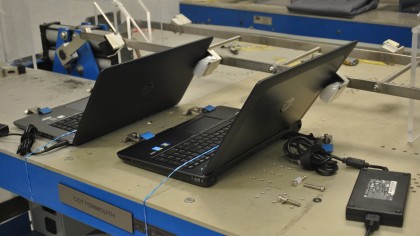Appetite for destruction: HP's product testing philosophy
Find out how HP tests ElitePads, EliteBooks and more
Klutzes are given a ton of consideration at HP's testing facility. Devices, and the packages they come in, are independently dropped from 30 inches and higher to determine their breaking points. They're also put into a vibration analysis machine that shakes the hell out of your devices with 1000 pounds of vibration force.
That's not to say you should go home and start using your Elite Pad as a Shake Weight. These tests are done to failure to determine what the breaking point is, not to guarantee that HP has created indestructible devices (they haven't).
Should a device mysteriously fail, HP has a failure analysis team that can examine product components at the microscopic level to determine why a failure occurred. HP's library contains more than 80,000 compounds that can be analyzed in fewer than 10 seconds at 1000X magnification. HP can scan metals at the same rate at 10,000X magnification.

If your EliteBook mysteriously breaks and HP wants to determine what has happened, they will break the device down into microscopic components to see where the error occurred.
An excellent real-life example is the man who told HP that a brown liquid at the bottom of his notebook burned his hands right before his notebook short-circuited. The man sent the computer to HP, which conducted a microscopic analysis to determine that the brown liquid was the man's cat's urine. HP does not actively test for cat urine, nor are any of their devices urine-proof (human or otherwise).
Skynet
Perhaps the most interesting room within HP's testing facilities, the Robot Room, is where HP conducts battery button analysis, keyboard and touchpad resiliency, and laptop hinge analysis. This room, which looks a lot like Skynet Labs, contains a robot whose sole job it is to press down on your power button and touchpads to determine how many presses the buttons can withstand before malfunctioning, as well as how many presses the buttons can withstand before their coats of paint wear away.

Laptop hinge analysis requires a robot that opens and closes your laptop 25,000 times over the course of seven days to determine whether or not HP's 32 types of hinges will break when combined with a specific chassis.
Sign up for breaking news, reviews, opinion, top tech deals, and more.

My favorite machine in the room simply presses down on screens to determine the weight at which your ElitePad display will shatter. When I was standing in the room the pressure from a five-pound barbell was barely altering the pixels on the ElitePad's display.

Keyboards: the Navy Seals of computing
Your keyboards go through the most rigorous testing (consider them the Navy Seals of computing). These bad boys sit inside a machine that rapidly presses down on each key 20 million times over the course of a month. Most keyboards don't make it all the way to 20 million, but it's important for HP to determine which keyboards are most resilient so that they can constantly improve upon design to one day reach 100% success at 20 million punches.
For all of you enterprise users, HP spends 133 thousand hours testing each of its software platforms before they are released to production. They test every aspect of the software, from performance to security to speed, and then they test every single piece of hardware that comes to life because of the software (such as chips, screens, fingerprint scanners, etc.).
Once the entire system is stable, HP will then run the software through partner systems to ensure that integrations don't backfire. This is a nine-month process, end-to-end, during which HP tries as hard as possible to not have to recall thousands of software licenses from its Fortune 500 clients. If your tablet stops working, that sucks. If HP's Client Security software licensed by a 20,000 person enterprise fails, well that's a whole 'nother level of disaster.
Deafening quiet after a day of chaos
Finally, after a long day of watching things snap, crackle and pop, we were brought into the electromagnetic semi-anechoic chamber, which tests the power, and direction of the radio frequency delivered by your device.

Ever wonder why your blender doesn't disrupt your Orange is the New Black stream? It's because guys in semi-anechoic chambers tested the immunity of certain radiofrequencies to guarantee the signals coming to and going from their devices.
The room is 36 feet wide and 45 feet long, and the quiet is so deafening it's almost hard to imagine that just outside its doors a motherboard is being burned, a workstation is being dropped, and an ElitePad is being stomped on.
- 1
- 2
Current page: Page 2: Drops, shakes and cat urine
Prev Page How HP prepares its products for consumer abuse